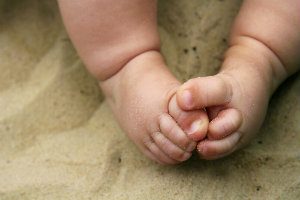Vertical Talus
It’s All About the AnglesA fun math concept is vertical angles, where no matter how you move two crossed straight lines, the opposite angles are always equal. Try it with two pencils to see what we mean. Unfortunately, not all children are born with all the bones of their feet at correct or equal angles. Vertical talus is a foot deformity where the talus bone in an ankle joint is pointed down instead of forward toward the toes, and it causes other bones in the foot to shift to the wrong positions, too.
Why the Talus Goes Vertical

Symptoms That Say Vertical Talus
The talus is a critical bone in the ankle on which the ends of the tibia and fibula (leg bones) rest. It helps transfer weight across the joint and enables movement of the foot. When it is tipped vertically instead of lying horizontally, the other bones of your baby’s foot move up over it.
This results in the foot tipping up toward the shin, and the bottom of it pushing in an outward curve instead of forming a normal arch (sometimes called a rocker-bottom sole). Don’t worry that your baby is in pain—the bones are too soft and malleable at this stage for that to be the case. However, if it is not treated your child could develop severe problems later as the bones harden and joints stiffen. They may be unable to wear normal shoes, and their walking and normal activities would be greatly hampered.
Treating vertical Talus
As with another foot deformity present at birth—clubfoot—this problem was treated surgically in years past. However, the procedure comes with risks of infection, stiffness, and over- or under-correction. Some physicians have begun using a conservative treatment based on the success of a revolutionary treatment for clubfoot—the Ponseti method. It uses a series of manipulations and castings to gradually move the talus and other bones to the right angles.
Once the bones are in correct position, the talus and navicular bones are fixed in place with a wire and a small procedure is done to loosen the Achilles tendon. That is followed by two more castings lasting eight weeks, and then your baby will wear a rigid ankle foot orthosis (AFO) 22 hours a day, while you stretch the soft tissues several times a day to maintain flexibility. The AFO may need to be used at naps and nighttime for the first couple of years to maintain the correction.
As with Dr. Nitza Rodriguez’s treatment of clubfoot, we are always glad to find ways of dealing with congenital deformities that don’t require surgery. Studies are limited, but this procedure is showing some good success, so we feel it is worthwhile to try before correcting the deformity surgically.
Consult the Experts in Child Foot Deformities
Treating pediatric foot deformities is one of our top concerns at Southern California Foot & Ankle Specialists, so if your baby’s feet need correcting, this is the place to come. Our office is located in Ladera Ranch, but we accept patients from all over the Saddleback Valley area and beyond. Just call us at (949) 364-9255 (WALK) or reach out to us online to find answers for your child’s condition.
Contact Us
Ladera Ranch
333 Corporate Dr. Ste 230, Ladera Ranch, CA 92694
Tel: (949) 364-9255 (WALK)
Fax: (949) 364-9250
Office Hours:
Monday - Friday: 9am - 5pm
*(Lunch 12 noon - 1pm)
Orange
2617 E Chapman Ave. Ste 303, Orange, CA 92869
Tel: (714) 639-7993
Fax: (714) 639-0729
Office Hours:
Monday - Friday: 9am - 5pm
*(Lunch 12 noon - 1pm)
